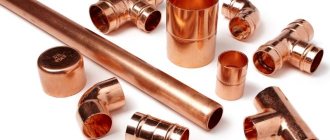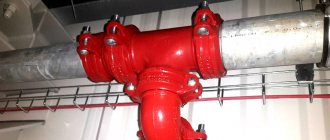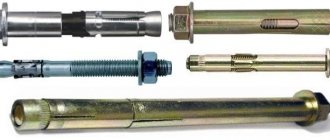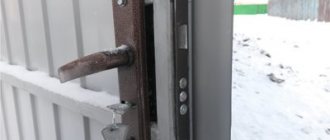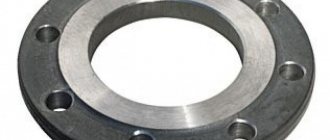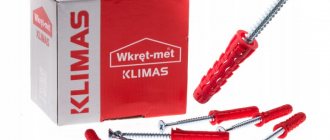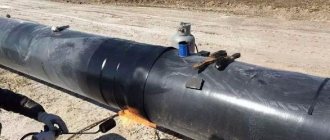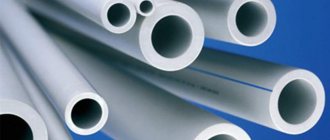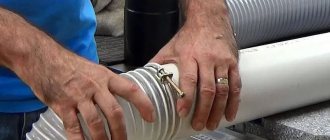Thermal insulation of pipelines is a set of measures aimed at preventing the heat exchange of the medium transported through them with the environment. Thermal insulation of pipelines is used not only in heating systems and hot water supply, but also where technology requires transportation of substances with a certain temperature, for example, refrigerants.
The meaning of thermal insulation is the use of means that provide thermal resistance to heat exchange of any kind: contact and carried out through infrared radiation.
The greatest application, expressed in numbers, is the thermal insulation of pipelines of heating networks. Unlike Europe, a centralized heating system dominates throughout the post-Soviet space. In Russia alone, the total length of heating networks is more than 260 thousand kilometers.
Much less often, insulation for heating pipes is used in private households with an autonomous heating system. Only in a few northern regions are private houses connected to the central heating main with heating pipes placed on the street.
For some types of boilers, for example, powerful gas or diesel boilers, the requirements of the set of rules SP 61.13330.2012 “Thermal insulation of equipment and pipelines” are required to be placed separately from the building - in a boiler room several meters away from the heated object. In their case, a fragment of the piping passing through the street necessarily needs insulation.
Pipe laying methods
On the street, insulation of heating pipelines is required both when installed above ground and when laid hidden - underground. The latter method is a channel method - a reinforced concrete trench is first laid in the trench, and pipes are already placed in it. Channelless placement method - directly in the ground. The insulating materials used differ not only in thermal conductivity, but also in steam and water resistance, durability and installation methods.
The need to insulate cold water supply pipes is not so obvious. However, you cannot do without it when the water supply is laid open above ground - the pipes must be protected from freezing and subsequent damage. But inside buildings, water supply pipes also have to be insulated - to prevent moisture condensation on them.
Scope of application
First of all, thermal insulation is used for heating, since there, along with preventing frost, it helps to save an expensive energy resource. It is recommended to insulate pipelines not only outside residential premises, but also inside, as well as in the boiler rooms themselves. After all, this will eliminate the energy consumption for heating non-residential rooms.
There are four main groups of insulating materials for heating communications:
- roll;
- cylindrical cut;
- cylindrical uncut;
- halves of a cylinder (format is better known as "shell").
In any case, it is necessary to calculate the installation of insulating structures for the exact diameter of the pipe. The appearance of a gap significantly reduces the effectiveness of the protection and can even lead to its failure. Important: slag mineral wool is not suitable for heating, or even for water supply or sewerage. The service life of cotton wool insulation is relatively short (it reaches 10 years only if it is completely dry and protected from mechanical factors). Foamed polymers are completely resistant to moisture and significant cooling.
All polymers are characterized by increased flammability, which significantly reduces the scope of their application. If structures made from them will be placed on large pipes, you need to choose products with 3-4 locks. For small and medium-sized pipelines, 2 locks are enough. Polyurethane foam performs better than polystyrene foam, and that is why it is recommended for the most critical pipes. Polyurethane foam insulation materials intended for heating circuits in homes are supplied exclusively as strong shells with a steel shell.
You can use polyurethane foam only with reliable protection from light. Foamed rubber with similar characteristics is recommended not for heating pipes, but for ventilation pipes.
It also works well for protecting the pipes through which the coolant flows. Important: if there is even the slightest chance of rodents, you should use glass wool. They chew through all other substances faster than you can talk about it.
As for water supply, it is necessary to insulate it mainly when pipes are forced to be laid above the freezing line. Important: if the problem is mild, you can simply increase the speed of the water flow. This is done through the use of pumps or receivers. A heating cable is also sometimes used. Cable heating is considered the most reliable and powerful way to protect against the cold.
This is the method recommended for seasonally used cottages. The supply of heat through an electric cable helps to quickly prepare the water supply for use, and when it is no longer needed, it can be stopped.
Thermal insulation itself is most often carried out by using rigid materials, these include:
- expanded polystyrene;
- Styrofoam;
- penoplex.
Both the quality of protection and cost are directly determined by density. Soft insulation is placed in the foam shell to cover possible flaws and voids. Roll insulation of water pipes is made with mineral and glass wool, furniture foam rubber, foil foam. Problems may be associated with the hygroscopicity of the materials used. In addition to protection from harmful environmental factors, you will have to think about how to secure the roll to the pipe.
Professionals note that it is easiest to insulate water pipes using segmental materials. It is this option (sometimes also called casing) that maintains the highest tightness and reliability. Another way to protect your water supply is by spraying polyurethane foam. It initially provides absolute impermeability to water. The consumption of the component used depends on the thickness of the poured layer.
When choosing an option for insulating water pipes, you must take into account the difference between pipes laid underground and above it. The difference remains even when the same type of material is used. Plastic and metal pipes require different insulation. If you need to protect the water supply on the street (under houses, in distribution wells), use any means that will maintain the necessary tightness and will not be destroyed by water.
An aboveground pipeline needs thicker protection than its underground counterpart.
The most difficult section is the one where the pipe rises to the surface. Here either the most powerful insulator is used, or weaker options are laid out in several layers. Covering the main insulating layer from moisture is achieved by wrapping it with plastic film or roofing felt. If both solutions are unacceptable, form a plastic box. In any case, care is taken to reduce to a minimum the number of joints, each of which forms a cold bridge.
The problem can be solved by laying out an insulating coating in the form of two mutually offset layers. But it’s not just the outer parts of the water supply that need to be protected from the cold. The covering of pipes connected to air conditioners also has its own subtleties. The purpose of protection in this case is to maintain the same performance of climate control equipment. When using uncovered pipelines, a considerable part of the energy is consumed through heat transfer. Calculations are made in advance and the location of the air conditioner and all associated pipes are determined. In this case, the required diameter of the insulating layer is calculated.
In most cases, channels serving climate control equipment are protected with synthetic rubber that does not have pores or polyethylene foam. But the hygroscopicity of mineral wool prevents its use in this case. It is much better to use mineral fiber products with a water-repellent layer.
Many pipelines in apartments and private houses are made of polypropylene structures.
The need to insulate them arises when placing:
- in the floor screed of the first floors;
- in floor screeds above unheated rooms;
- near external door and window openings.
It is also necessary to protect polypropylene pipelines entering the water supply and heating risers. They can be covered with basalt cylinders. But this is a rather expensive material, which limits its use. Foam is more versatile.
Another advantage of this material is the ability to use it many times in a row.
Insulating outdoor water pipes using glass wool is significantly complicated by the danger of its dust particles for the skin and respiratory system. Preparing the casings becomes a prerequisite. All metal pipes laid outside must be painted at the preparation stage. As for the insulation of sewage systems, it must be carried out in unheated rooms and in open areas. The only exception to this rule is in areas where in winter the temperature is guaranteed not to drop to negative values.
Of course, in Russia this is only a theoretical assumption, since in reality there are no such areas.
In most cases, sewer pipelines, including those from HDPE, cover:
- mineral wool in various formats;
- expanded polystyrene;
- expanded clay;
- polyurethane foam.
Liquid insulating elements are occasionally used. All such options are considered passive varieties. But sewerage, like other types of pipelines, is often protected using cable heating. Mineral wool should be used with caution to protect sewer systems because it contains formaldehyde resins and can be destroyed under significant mechanical stress. This makes it significantly more difficult to achieve effective thermal insulation.
Cotton insulation is used when it is necessary to cover the free areas of the channels. They cannot be laid in the soil. Wet cotton wool of any type very easily loses its characteristics. And if the pipes are made of metal, they often begin to rust quickly. To install it yourself, you need to use polystyrene foam.
Utility systems often include copper pipes, which have impressive practical properties. But even they need effective thermal protection. In most cases, copper pipelines are covered with foam materials. Such products are suitable not only for air conditioning ducts, but also for all water supply systems and heating lines.
Thermal insulation is also important for heated floors. As calculations show (and practice confirms), floors without insulation in an identical configuration under similar conditions consume 20% more energy. Cork substrates are widely used to stop heat flow. Their advantage is ideal environmental quality and excellent strength. Please note: cork has zero adhesion to cement screeds and blocks.
Installation of cork heat-shielding elements is possible if the ceilings allow it. Cork inevitably raises the floor by 40-50 mm. Therefore, it is unacceptable in rooms with low walls. The most popular method of thermal protection for heated floors is extruded polypropylene. The structure of its plates contains closed cells.
Polypropylene is well processed, it will not be difficult to install it even where the floor configuration is very sophisticated. In addition, the synthetic material does not absorb water and can be used at temperatures up to 130 degrees. Water-heated floors are mainly protected using polystyrene foam. Important: when choosing polymer structures, you need to carefully study their chemical composition. Sometimes it contains toxic components that will be released when heated.
To complete the overview of the areas of application of thermal insulation, it is appropriate to protect chimney pipes placed inside walls.
Help prevent heat loss and damage to the chimney from condensation:
- mineral wool;
- fiber products;
- slag concrete and structures based on it;
- brick break;
- foam glass.
Materials that are easily flammable and can be destroyed by heat are naturally prohibited. Professional builders try to use cinder blocks. This option is quite heavy and requires careful design taking into account the load on the roofing and load-bearing elements.
For independent work, flexible and soft mineral wool is much better suited. Attention: no matter what, where and with what is insulated, it is necessary to take into account the instructions for pipelines and insulating materials.
Glass wool, mineral wool
Insulating materials proven by practice. Meet the requirements of SP 61.13330.2012, SNiP 41-03-2003 and fire safety standards for any installation method. They are fibers with a diameter of 3-15 microns, close to crystals in structure.
Glass wool is made from waste from glass production, mineral wool from silicon-containing slag and silicate waste from metallurgy. The differences in their properties are insignificant. Available in the form of rolls, stitched mats, plates and pressed cylinders.
It is important to be careful with materials and know how to handle them correctly. Any manipulations must be performed in protective overalls, gloves and a respirator.
Installation
The pipe is wrapped or lined with cotton wool, ensuring uniform filling density over the entire surface. Then the insulation, without too much pressure, is fixed using a knitting wire. The material is hygroscopic and easily gets wet, so insulation of external pipelines made of mineral or glass wool requires the installation of a vapor barrier layer made of a material with low vapor permeability: roofing felt or polyethylene film.
A covering layer is placed on top of it to prevent the penetration of precipitation - a casing made of roofing tin, galvanized iron or sheet aluminum.
Basalt (stone) wool
More dense than glass wool. The fibers are made from the melt of gabbro-basalt rocks. Absolutely non-flammable, can withstand temperatures up to 900° C for a short time. Not all insulating materials, like basalt wool, can be in long-term contact with surfaces heated to 700° C.
Thermal conductivity is comparable to polymers, ranging from 0.032 to 0.048 W/(m K). High performance indicators make it possible to use its thermal insulation properties not only for pipelines, but also for the installation of hot chimneys.
Available in several versions:
- like glass wool, in rolls;
- in the form of mats (stitched rolls);
- in the form of cylindrical elements with one longitudinal slot;
- in the form of pressed fragments of a cylinder, the so-called shells.
The last two versions have different modifications, differing in density and the presence of heat-reflecting film. The cylinder slot and the edges of the shells can be made in the form of a tenon joint.
SP 61.13330.2012 contains instructions that the thermal insulation of pipelines must comply with safety and environmental protection requirements. Basalt wool itself fully complies with this instruction.
Manufacturers often resort to tricks: to improve consumer performance - to make it hydrophobic, more dense, and vapor permeable, they use impregnations based on phenol-formaldehyde resins. Therefore, it cannot be called 100% safe for humans. Before using basalt wool in a residential area, it is advisable to study its hygienic certificate.
Installation
The insulation fibers are stronger than glass wool, so it is almost impossible for its particles to enter the body through the lungs or skin. However, it is still recommended to use gloves and a respirator when working.
Installation of rolled sheets is no different from the method of insulating heating pipes with glass wool. Thermal protection in the form of shells and cylinders is attached to the pipes using mounting tape or a wide bandage. Despite some hydrophobicity of basalt wool, pipes insulated with it also require a waterproof, vapor-permeable shell made of polyethylene or roofing felt, and an additional one made of tin or dense aluminum foil.
Advantages and disadvantages of individual insulation materials
Each of the insulation materials has its own advantages and disadvantages that limit their scope of application; these factors are taken into account when choosing a suitable material for specific conditions.
Fiber wool
Insulation materials made from glass and basalt wool are widely popular among consumers due to their affordability and environmental friendliness, allowing their use inside residential premises. Mineral wool has the following properties:
- Fire-resistant, in case of fire they do not burn and release substances harmful to health; they melt when exposed to too high a temperature.
- Glass wool has low rigidity and easily wrinkles, basalt-based material is stiffer, both types restore their shape after physical impact.
- Mineral wool has a high degree of moisture absorption; because of this disadvantage, shells made of quartz and basalt are not laid directly underground.
- Cotton wool is resistant to most aggressive chemicals and the biological effects of microorganisms, bacteria, fungi, and mold.
- With the exception of slag wool, mineral wools are environmentally friendly natural materials and are safe for human health.
- The material allows air to pass through well and prevents the accumulation of moisture and condensation under its surface.
Rice. 15 Thermal insulation of heating pipes on the street
Soft foam materials
Foamed polyethylene materials for pipeline insulation are produced in the form of tubular shells with a longitudinal slot; their characteristic differences from other types of insulation are:
- Polyethylene in its normal state is harmless to health.
- PE is a chemically and biologically neutral material that is not subject to rotting and resists the appearance of fungus and mold.
- It is moisture-proof, therefore it is often used as vapor and waterproofing in combination with materials with high adhesion (mineral wool).
- Depending on the manufacturer, foamed polyethylene does not support combustion or is slightly flammable (groups G1, G2), while during its ignition substances that are harmful and dangerous to human health are released.
- Foamed polyethylenes and rubber do not shrink and quickly regain their shape after applying physical force.
- Porous rubber is designed to adhere to metal surfaces - thus providing long-lasting and reliable insulation of pipelines.
- For ease of use, some tubes at the longitudinal seam are coated with an adhesive composition (self-adhesive varieties) - this allows you to hermetically isolate objects without cold bridges.
- For external use, tubes made of foamed polyethylene are produced in moisture-protected versions with surface films of various colors.
- Protection made of tubular foam polyethylene is quickly installed, has a beautiful aesthetic appearance of a closed shell, and is therefore widely used in households.
- Due to its low rigidity, the material is used on surface pipelines, popular brands: Energoflex, Jermaflex, Porilex, Vilaterm.
Rice. 16 Application of mineral wool for pipe thermal insulation
Hard shells made of polystyrene foam and polyurethane
Durable and rigid foam plastic, polyurethane shells in the form of a shell from several segments have the following qualities:
- The manufacturing material is biologically inert and resists most aggressive chemicals.
- They do not allow water and moisture to pass through, being vapor and water insulators.
- Polystyrene foam is one of the cheapest materials.
- The material is divided into several groups according to density and rigidity; its extruded variety has the highest parameters.
- Foam plastics are low-flammable; in case of fire they release a large amount of toxic substances in the form of black smoke.
- Due to the destructive effect of ultraviolet radiation on their structure, foam and polyurethane foam shells are recommended for use in underground pipeline laying.
- The low maximum permissible temperature of foam plastic, about 70 °C, is an obstacle to the use of PS in metal pipelines transporting steam or boiling water.
- For outdoor use, given the low strength and fear of ultraviolet radiation by polystyrene foam and polyurethane foam, they are placed in a hard shell made of thin-walled galvanized casings.
- Almost all foam shells are manufactured by commercial small businesses, so if a suitable diameter is not available, the protection can always be made to order in the required size and configuration.
Rice. 17 PE insulation on a heating pipe in a private house
Thermal insulation paint
Domestic manufacturers produce a wide range of thermal paints, the most famous brands being Bronya and Corundum, which have the following advantages and disadvantages:
- Thermal paints are applied to objects by brush or spraying; due to their high adhesion, they adhere well to surfaces made of any materials.
- The cost of paints sold in plastic buckets is too high due to imported raw materials; the price for a 5-liter bucket starts at 1,500 rubles.
- Manufacturer's recommended paint consumption: 1 liter per square meter to obtain an optimal layer of 1 mm thickness.
- Thermal paint is convenient to use on surface hard-to-reach and non-standard sections of pipes, insulation of flange joints, and its underground use is practiced for insulating steel pipelines.
- In addition to thermal insulation, thermal paint provides anti-corrosion protection for objects.
Foamed polyurethane (polyurethane foam, PPU)
Reduces heat loss by more than half compared to glass wool and mineral wool. Its advantages include: low thermal conductivity, excellent waterproofing properties. The service life declared by the manufacturers is 30 years; The operating temperature range is from -40 to +140 °C, the maximum withstandable for a short time is 150 °C.
The main brands of polyurethane foam belong to the flammability group G4 (highly flammable). When the composition is changed by adding fire retardants, they are assigned G3 (normally flammable).
Although polyurethane foam is excellent as an insulating material for heating pipes, keep in mind that SP 61.13330.2012 allows the use of such thermal insulation only in single-family residential buildings, and SP 2.13130.2012 limits their height to two floors.
Might be interesting
Thermal insulation
Insulating the ceiling in a bathhouse - methods, materials, useful...
Thermal insulation
Tables of comparative characteristics of thermal insulation…
Thermal insulation
Why polyurethane foam insulation is the best...
Thermal insulation
Self-adhesive thermal insulation: how to choose and apply?
Thermal insulation coating is produced in the form of shells - semicircular segments with tongue and groove locks at the ends. Ready-made steel pipes insulated with polyurethane foam with a protective sheath of polyethylene are also available for sale.
Installation
The shells are secured to the heating pipe using ties, clamps, plastic or metal bandage. Like many polymers, the material does not tolerate prolonged exposure to sunlight, so an open ground pipeline when using PPU shells requires a covering layer, for example, galvanized steel.
For underground ductless placement, thermal insulation products are laid on waterproof and temperature-resistant mastics or adhesives, and the outside is insulated with a waterproof coating. It is also necessary to take care of the anti-corrosion treatment of the surface of metal pipes - even the glued joint of the shells is not tight enough to prevent the condensation of water vapor from the air.
Secrets of proper insulation of water pipes
It is definitely recommended to draw up a detailed diagram of underground water supply lines in the house and on the land, and also pay close attention to the connecting elements.
Remember that just one small drop of water that freezes in the threads can break them. And the pipes, in turn, should not be subject to corrosion; the best option is metal-plastic.
It is recommended to insulate and heat all sections of the pipeline that are at negative temperatures. This applies to rooms in the house, for example, unheated basements, and places where pipes enter buildings.
One of the methods for insulating water supply pipes in a dacha at the entry point is the following: place short sections of water supply up to 0.5 meters that remain uninsulated in pipes of larger diameter.
To do this, it is customary to use PVC sewer pipes with a diameter of 100 - 150 millimeters, sawing it lengthwise in advance. Next, you should center and secure everything with tape.
Drill several holes in height and fill the space between the pipes with construction foam from a can. As you fill, you can close the holes with the same tape.
Remember, warm water pipes in winter become objects of increased attention from various rodents - moles, rats and other living creatures. They can easily chew through insulation, asbestos and plastic pipes, considering them the most suitable warm place.
You can protect water pipes from them by plastering them with a solution of broken glass, wrapping them with a metal mesh, or using a metal sleeve.
This completes the pipe insulation procedure. If the instructions are followed correctly, the pipe will last a long time and at the highest level, without fear of severe frosts. I would like to remind you once again that insulation of the water supply system should be done in a timely manner, without waiting for a rupture to occur as a result of freezing water.
Always consider the water repellency, durability and fire safety requirements of the insulating material.
Source: strport.ru
Expanded polystyrene (foam plastic, EPS)
It is produced in the form of shells, practically no different in appearance from polyurethane foam - the same dimensions, the same tongue-and-groove locking connection. But the temperature range of use, from -100 to +80 °C, with all this external similarity, makes its use for thermal insulation of heating pipelines impossible or limited.
SNiP 41-01-2003 “Heating, ventilation and air conditioning” states that in the case of a two-pipe heat supply system, the maximum supply temperature can reach 95°C. As for the return heating risers, not everything is so simple: it is believed that the temperature in them does not exceed 50 °C.
Foam insulation is more often used for cold water and sewer pipes. However, it can be used on top of other insulation materials with a higher permissible temperature of use.
The material has a number of disadvantages: it is highly flammable (even with the addition of fire retardants), does not tolerate chemical influences (dissolves in acetone), and crumbles into balls during prolonged exposure to solar radiation.
There are other non-polystyrene foams - formaldehyde, or phenolic for short. In fact, it is a completely different material. It is devoid of these disadvantages and is successfully used as thermal insulation for pipelines, but is not so widespread.
Installation
The shells are secured to the pipe using a bandage or foil tape; they can be glued to the pipe and to each other.
What properties should an insulating material have?
Insulation for pipes, depending on the scope of application (laying underground or external communications), must meet the following requirements:
- Low level of thermal conductivity, which will help maintain the temperature of the coolant in heating and hot water supply pipelines, as well as prevent warm ambient air from heating the pipeline in cooling devices and appliances.
- Materials used for insulation must meet sanitary and fire safety standards and have self-extinguishing properties.
- Insulation cannot be overly hygroscopic, since the amount of air in the structure of a wet material decreases, the amount of which determines its thermal insulation properties.
- Thermal insulation should be easily installed on pipes of any diameter and configuration, with the formation of a minimum number of joints, which eliminates the presence of cold bridges.
- The material must be durable and maintainable, as well as the possibility of its repeated use.
- Possess high resistance to aggressive environments, mechanical strength, and withstand sudden temperature changes.
- Material available at an affordable price.
But you shouldn’t buy cheap insulation, as this can lead to even greater costs if the pipe freezes in winter.
Foamed polyethylene
The temperature range at which the use of high-density polyethylene foam is allowed is from -70 to +70 °C. The upper limit is not compatible with the maximum temperature of the heating pipe, usually accepted in calculations. This means that the material is of little use as thermal insulation for pipelines, but can be used as an insulating layer over a heat-resistant one.
Polyethylene foam insulation has found virtually no alternative use as protection against freezing of water pipes. Very often it is used as a vapor barrier and waterproofing.
The material is produced in the form of sheets or in the form of a flexible thick-walled pipe. The latter form is more often used, as it is more convenient for insulating water pipes. Standard length is 2 meters. Color varies from white to dark gray. There may be a coating of aluminum foil that reflects IR radiation. The differences relate to internal diameters (from 15 to 114 mm), wall thickness (from 6 to 30 mm).
The application ensures the temperature on the pipe is above the dew point, which means it prevents the formation of condensation.
Installation
A simple way with worse vapor barrier results is to cut the foam material along a small depression along the side surface, open the edges and put it on the pipe. Then wrap it along the entire length with mounting tape.
A more complex solution (and not always feasible) is to turn off the water, completely disassemble the insulated sections of the water supply system and put on solid sections. Then put everything back together. Secure the polyethylene with ties. In this case, only the junction of the segments will become a vulnerable point. It can be glued or also wrapped with tape.
Features of CPI coating
Cement-sand insulation initially provides resistance to mechanical damage and shock. Chemical protection is activated the first time the transported substance passes through the highway. The fluid flow affects the CPI. The smallest grains of insulation are pressed and spread over the steel surface, filling the pores on the walls of the pipeline. The process is accompanied by the formation of calcium hydroxide, which completely suppresses corrosion.
The thickness of the insulating layer is 4-16 mm along the length of the pipe and from 3 mm at the welds. The compressive strength of the CPI coating is not lower than 445 MPa. The only sources of metal destruction are aging and mechanical damage.
The applied coatings prevent the formation of mineral, biological and paraffin deposits. This expands the scope of use of pipelines and saves energy consumption.
Foam rubber
Foamed synthetic rubber with a closed-cell structure is the most versatile material for preserving heat and cold. Designed for a temperature range from -200 to +150 °C. Meets all environmental safety requirements.
It is used as insulation of cold water pipelines, insulation of heating pipes, and is often found in refrigeration and ventilation systems. Heating pipes laid inside buildings and insulated with rubber do not require the installation of a vapor barrier layer.
Externally similar to foamed polyethylene, it is also available in the form of sheets and flexible thick-walled pipes. Installation is also practically no different, except that such thermal insulation of pipes can be attached with glue.
Reasons for thermal insulation
There are two reasons why all thermal insulation work is carried out:
- Prevention of emergency situations. Frozen water often causes pipes to break. The influence of low temperatures significantly affects the quality of the product material and its overall integrity. The solution to this problem is high-quality insulation of unprotected sections of pipes.
- Reducing energy costs for heating. Many pipeline channels are located on the street: either in contact with the ground or at a short distance from it. The structures reduce the temperature due to high heat transfer to the environment. Lack of proper thermal insulation will entail high financial costs and will also reduce the quality of the material from which the pipeline channels are made.
Thus, thermal insulation of pipelines and equipment is an integral measure.
